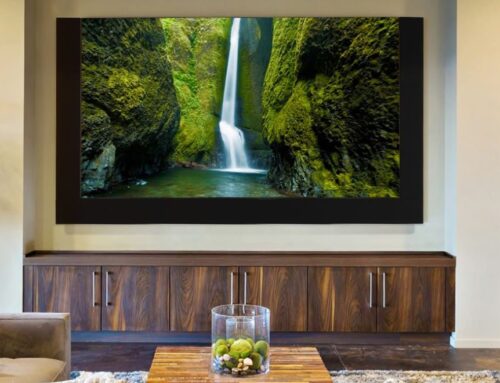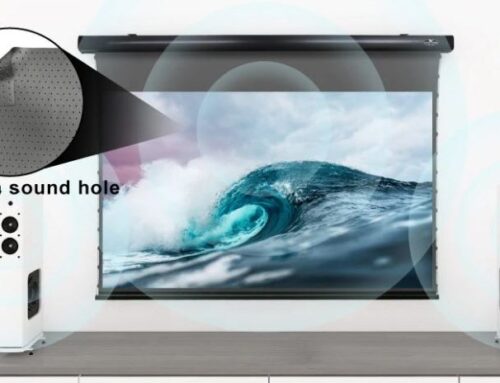Projector Screens ALR Vs Matt White
Ambient light rejecting screens are a shot in the arm for projector screen technology achieving bright and vivid images without having to take into consideration room lighting conditions, they produce high contrast solid colour and fine details in dark scenes but also vibrant colours and contrast in brighter scenes. If you want to use your projector day in day out then an ALR screen is for you, bringing the Big screen experience home in almost any room with the same viewing angles and black levels you get from a TV.
The Value
Matte white screen have been the traditional “go to” projection screen for years, you can find allot of deals by going on the web and typing “home cinema projector screens” into Google, you will find projector screens over 100” from £100 to £1,800 retail, you will see specifications for electric and drop down screens and fixed screens also, but today our focus in on the on projector the material part of the specs, you will wonder why the one with ALR (ambient light rejecting) is £300 more but why is this projector screen is £300 more?
Matt white Projector Screens
You will find most 100″ Projector screens up to £800 are Matte white projection screens a technology that’s been in home theatres for years, originally developed for the luxury market and installed into a purpose built rooms, rooms designed for cinema and big enough to accommodate a large viewing group, there was little need for improvement until the darkness of the dedicated theatre room gave way to the well-lit open plan recreation and living rooms we see today. In most modern room applications the technology is just not satisfactory when taking into account a rooms lighting conditions and even when you do get the correct lighting conditions you can be left stumbling in the darkness for the remote or failing to eat your popcorn and snacks.
Technology Race
Manufactures have been competing in the race to serve consumers well over the last 10 years by producing extraordinary quality projectors at unbelievably low costs. The results have established the manufacture of projector screens with an efficient process that’s cheap and can be produced on a mass scale, now giving customers access to a quality home theatre projector and screen setups affordable to even a modest budget.
Why ALR?
The problem with using a matte white projector screen in a “TV” environment is that the image gets washed out by ambient light. Ambient light rejecting (ALR) projector screen materials were the obvious answer. They enhance the visual qualities of a projected image while preventing the milky glare of ambient light from spoiling the picture. What started as a “must have” for the select few who could afford it has become an industry norm for everyone interested in “bringing home the big screen.”
Matt White Vs ALR
Matte white is still the most common type of projector screen on the market today. It typically has a 1.0 – 1.2 gain classification. Gain is the measure of a projector screen’s ability to make a projected image brighter/duller. Matte white screens make up the neutral medium of gain that is around ±1.0 gain. Magnesium carbonate (MgCO3) is the often-accepted control point of 1.0 gain against which the brightness of projector screens is typically compared. Because it is the measured point of dynamic range that comes the closest to “pure white,” magnesium carbonate is typically an essential ingredient in the manufacture of matte white projector screens, as well.
Matt White Advantages
The advantages of matte white screen materials are versatile and cost less. Matte white screen materials are versatile because of their wide diffusion uniformity, which means that an equal amount of brightness will be reflected into a viewer’s field of vision regardless of how far centred or off axis their viewing angle is. (Figure 1) Due to the low cost and ease of construction, matte white projection screens are much cheaper to make. Because of this, matte white projector screens are preferred especially in dedicated cinema rooms where there is a control over ambient light and the room has been designed for the perfect cinema environment.
Matt White disadvantages
Matte white projection screens are easily washed out by ambient light and they do little to enhance image brightness and/or contrast. Ambient light is essentially all the light in your projection environment that is not coming from your projector. Because matte white screens do so well at uniform diffusion, they will also reflect ambient light causing your reflected screen image to be washed out. In addition to this, matte white is neutral, so it does little to enhance contrast with either the dynamic range of black levels or colour. Any necessary enhancements to colour temperature, saturation or black levels are left entirely up to the projector and its installer’s ability to calibrate it properly.
Ambient Light Rejecting (ALR)
ALR materials can filter out ambient light to provide and even surpass “TV panel” brightness regardless if the lights are on or off. They typically consist of a highly reflective base layer topped with a series of diffusion layers that filter out off-axis lighting. ALR materials also serve a dual role of enhancing the picture’s dynamic range so that the image may be brighter, colours more vibrant, and black levels more defined. In the case of angular reflective ALR screens, the reflective base compresses the brightness into a narrower “half-gain cone,” which in turn enhances the picture’s luminescence. Its outer diffusion layer gives the screen material a grey appearance. The ALR screen appears grey to our eyes because it is filtering out the ambient light from the room. Because a white screen doesn’t filter out ambient light, we see it as a white projection surface. The ALR screen filters most of that light out, leaving us with a grey projection surface to look at. This is why these ALR projector screens are commonly referred to as “Grey,” “Dark,” or “Black” screens.
Which one should you choose?
ALR screens do vastly outperform matte white screens with superior brightness when filtering out ambient light, for the industry it is very exiting times as you can bring the big screen experience home to most modern room layouts. This is desirable to the majority of people looking to invest in a home cinema but necessarily don’t have the space for a dedicated room. If a dedicated room is something that is wanted and the lighting conditions are forgiving enough I would still recommend the same Matt white screens the commercial cinemas do.
FREE DISNEY PLUS FOR A YEAR
If you are interested in the purchase of a projector & ALR screen setup from us then we will look to beat any web pricing, we can install it and you will get a 5 year warranty and Disney plus for one year.
Please call us on 07738126366, email me direct on robin.barnes@digicastav.co.uk or click here to email us






